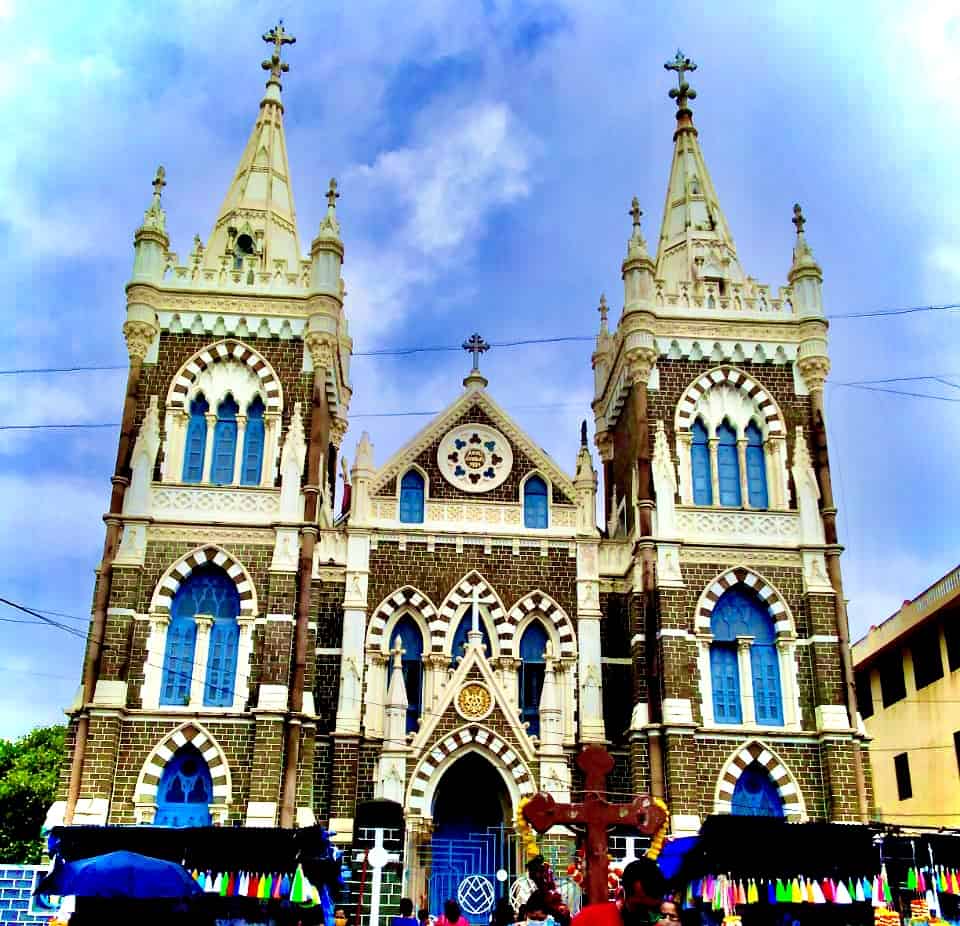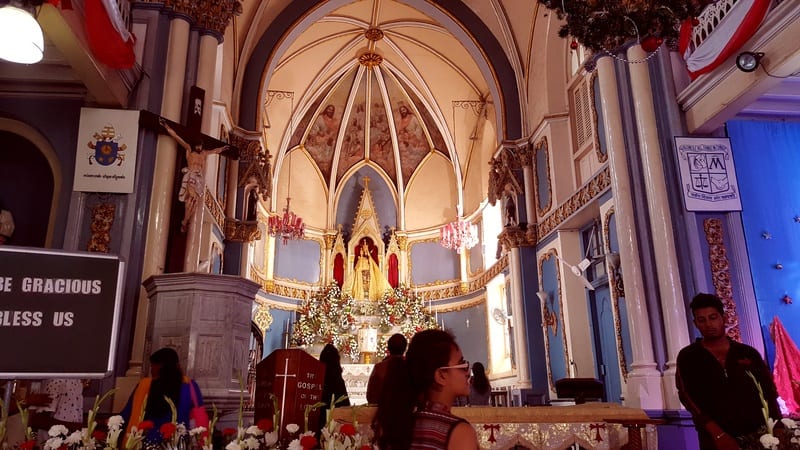
The churches of Mumbai are beautiful due to the preserved British Influence. Perhaps because of Victorian or Roman design, Mumbai’s iconic structures have been a major tourist attraction since the ages.
The churches in Mumbai are also a significant part of the variety of architecture that Mumbai has in its cityscape. For a chance to see some of the finest architectural styles that Mumbai has to offer, it is essential to visit the churches of Mumbai.
1. Mount Mary Basilica, Bandra
The Basilica of Our Lady of the Mount is a century-old Roman Catholic Basilica that stands high on the hill of Bandra (then called Bandora). The statue inside was brought in by Jesuits from Portugal during the sixteenth century.
It was put in its main altar, which was the small chapel on the summit of this hill. Over time, this Basilica has attracted people of all religions, especially during its Bandra Fair.
There is a belief that all requests for assistance, whether for illness or business improvement or purchasing a home, can be fulfilled in this Basilica.
It is so popular that the mountain upon which it sits is now referred to as Mount Mary Hill.

2. St Michael’s Church, Mahim
Between 1512 and 1585, according to different sources, St Michal’s Church is the oldest Christian place of worship in the town. It was damaged in the war of 1687 under the Mughal Emperor, Aurangzeb, but was quickly restored.
The current structure was built in 1973. It might be a simple white and red structure with no ornamentation; however, what this renowned Church in Mumbai has in terms of aesthetics the Church more than makes up for with the peace that you can feel within.
This is the Church that was the site of the image that showed Christ bleeding from his heart in 2008. This is no surprise, as it appears on Mumbai’s top church list.
The annual novena attracts many people to the church, and it is believed that those who attend the novena and ask for favors are granted.

3. Holy Name Cathedral, Colaba
Built-in 1905, the Cathedral of the Holy Name is the archbishop’s residence in Bombay. The Church is constructed entirely of limestone and is an outstanding Gothic architecture. The inside of the Church is filled with notable items, including the elaborate gravestones of Archbishops.
The Church’s ceiling is covered in images of the Nativity scene, as well as a stained-glass window enhances the beauty that the cathedral has to offer. The ideal moment to go is during Christmas Eve, as the cathedral is decorated with elaborate decorations.
4. St. Peter’s Church, Bandra
This Church was constructed in 1938 on the site of an earlier church built in 1853, imitating the Romanesque style. The building was constructed to give more space to the needy parishioners and the orphans.
It is located on the bustling shopping avenue in Hill Road; this is an absolute must-see, especially during Midnight Mass. The Church also has schools: St Stanislaus for boys and St Joseph’s Convent for girls.
With its stunning design and spacious space, St. Peter’s Church in the busy neighborhood of Bandra is among the most beautiful in the town. It is reminiscent of a Roman Cathedral; the design and the history of the Church date back to the 17th century, as well as an enormous granite statue depicting Christ the Redeemer in the middle of the courtyard.
The wooden doors open up to a vast space filled with gorgeous glass art arches, relics, and arches from religious relics of the Catholic faith. The most striking pieces include the angels in marble positioned at the foot of the altar and the beautiful tabernacle constructed in the typical Gothic style.
5. Cathedral of the Holy Name, Colaba
It was inaugurated in 1905 and is ,if you believe me, the most beautiful Church in Mumbai. A different Gothic church with pointed arches, soaring buttresses, and conical-topped towers appear like a castle built in Medieval Europe.
The ceiling is high and ribbed, bursting with bright frescoes and pillars with statues on their capitals and geometric designs on the walls, which had me thinking they were wallpapers. The stained glass windows make you feel like you’re in the streets of an Italian city, like Venice.
Another thing that catches the eye is the white marble altar that is home to three life-sized idols of Jesus. You can visit during Mass for a chance to hear the famous organ fill the air with gentle music.
6. Gloria Church, Byculla
Gloria Church is one of Mumbai’s oldest Roman Catholic churches, constructed by the Portuguese Franciscans in 1632. The Church is situated in Byculla, just next to the railway station.
The contemporary Gloria church was constructed in an English Gothic style in 1911 in Byculla. It was designed to resemble a Latin Cross with lofty Towers with four Turrets reaching 160 feet in height. The Church was reChurchd in time for the century year.
7. St Anne’s Church, Mazgaon
St. Anne’s Church was built way back in 1787 as a small Chapel located on Nesbit Lane. It started as a place of private services, i.e., it was a private chapel to one family who went under its name Nesbit and later was opened to the public, though not meant to be used by all of the faithful.
It was also known as Igreja da Santa Anna. It was a place of worship for Portuguese priests who spoke Portuguese. Jesuits didn’t appear until the 19th century, and it is believed that it was the Jesuits who began using the title Saint Anne’s Chapel.
It was rebuilt in 1880-1881. Its foundation store, Saint Anne’s Church, was laid on April 10, 1880, and November 6.
Morning Mass is the soft morning light that filters down through the stunning and vibrant stained glass windows that line the eastern portion of the Church. The Church shows Christ’s Ascension of our Lord.
The window just to the right of this main window shows The Descent of Jesus Christ, the Holy Spirit; to the left is The Coronation of Our Blessed Lady and The Glory of All the Saints
8. St Andrew’s Church, Bandra
St. Andrew’s Church is one of the oldest churches in Mumbai. It was first constructed as a church by Portuguese Jesuits in 1575. It is located near the beach in Mumbai’s Bandra area of Mumbai and was the sole Church until the quarter of the 17th century.
The altar in the Church extends to the roof and houses sculptures depicting Sacred Heart, Our Lady, and St Andrew. A few smaller statues of St John The Baptist, St Sebastian, and the Bom Jesu are above the main statues.
The 16th-century wood altars to the side were carved and painted in the popular Portuguese style. The Church also has 16th-century hanging wood panels depicting the Resurrection of Christ, the Assumption of Mary, and Mother Mary.
Mumbai’s largest and most ancient stone crosses are situated in the compound. The cross of this stone is made from one stone. It was initially erected at the old Church of St. Anne. It was later removed.
9. St. Thomas Cathedral, Kala Ghoda, Fort
It was first constructed in 1718 and is among the most prominent churches built in Mumbai. It may not appear impressive from the outside, but the altar represents the magnificence Gothic architecture is renowned for.
The stained glass windows, red brick floor tiles with geometric designs, stucco work on the walls, and the high ceilings that are ribbed instantly.
It is also worth seeing an obituary to the Reverend Thomas Carr, who served as the first bishop of Mumbai. Have you ever thought that is the building that created the Churchgate station the name? When you visit here, you’re not just visiting the Church but also the history of Mumbai.
10. Afghan Church, Colaba
The Church of St John the Evangelist, also known in the Afghan Church, is a church with an Anglican heritage that is a part of the Mumbai diocese of the Church of North India. The Church is situated in Mumbai, Maharashtra, India.
It was constructed in 1847 by the British between 1847-1858 to honor those who died in the First Afghan War and the devastating retreat in 1842 from Kabul.
The memorials in the rear of the nave reflect the deaths of soldiers in the Second Anglo-Afghan War. In 1847, the foundation stones were laid. It was dedicated in 1858. Work for the steeple was completed in 1865.
The Church was constructed in the style of Henry Conybeare; architect William Butterfield was responsible for the reredos and pews, tiles, and the screen. William Wailes made the stained glass.
The massive structure was built by using locally-available buff-colored limestone and basalt. Its interior is renowned for its broad gothic archways and stunning stained-glass windows. The chapel comprises an aisle and nave, with a chancel measuring 50 feet (15 millimeters) across and 27 feet (7 meters) wide.
The tiles Butterfield used to create the geometric floor pattern were brought in from England. The windows to the east and west were made for the Church by William Wailes, an early nineteenth-century stained-glass expert.
Eight bells of considerable size in the bell tower are directly from the Taylor bell foundry in England in 1904 and are regarded as the top in the western region of India.
Leave a Reply